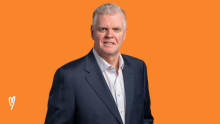The art of building organisational culture: Kyndryl CHRO Maryjo Charbonnier

Back in November 2021, IBM separated its managed infrastructure services business into a new, publicly traded company, Kyndryl. With 90,000 people in more than 60 countries and approximately $19 billion in revenue, Kyndryl is the world's largest standalone IT infrastructure services provider. It was also one of the world's biggest spinoffs when the separation completed, and it happened at a time that was both incredibly challenging, and filled with opportunity for the tech industry.
What does it take to drive the transformation strategies and initiatives of such an enormous spinoff, particularly the people and work aspect? People Matters met up with Maryjo Charbonnier, Chief Human Resources Officer of Kyndryl, who shared her experience with shaping the culture of a brand new company that just two years ago was a division, albeit an enormous one.
With almost thirty years in the profession, Kyndryl is the second spinoff Charbonnier has been part of – the first was Broadridge, the brokerage services group of ADP in 2007. Here's what she told us about her latest experience.
This interview was originally published in the February 2023 edition of People Matters Digital Magazine.
What has it been like, building the organisational culture for a spinoff as enormous as Kyndryl?
It was a challenge to spin off during the pandemic, when the market was in a very disrupted place. But we also had a huge opportunity in the form of the freedom to form new partnerships and support our customers in in new ways. To do that, we knew that part of what we had to change was the culture. And by culture, we mean the spoken and unspoken messages: what behaviour is tolerated, discouraged, or encouraged, what systems and symbols we share and use to communicate.
So where did we start on that journey, knowing that it takes a lot of energy to get 90,000 people moving? We started by really listening to our employees about what mattered to them. We already had a well defined foundation to build on, because we like to think of ourselves as a startup, and we had a culture to begin with. So we asked employees: what is important to them? We listened to what they told us they wanted to keep and what they wanted to change. And we decided right from the start that we would really focus on behaviours.
We chose behaviours because that is how values and principles are expressed in a culture, and I like to say that if you can't express the culture, then you haven't really defined it.
Our six behaviours are divided into two categories. The first is about how we want to interact with ourselves, our customers, and our communities, and those are restless, empathetic, and devoted. The second is about how we want to organise our work, and those are flat, fast, and focused. We wrote these down, we codified them, and then at our very first executive meeting ever, just three months after we became a public company, half of the meeting was spent talking about the culture and the leadership behaviours.
Yes, we talked about the business too, but we really wanted to send a message about the importance of culture.
How did you trickle that discussion down into practice?
We developed a training system for the people managers. Within the first year, we trained almost 80% of all our people managers on the leadership behaviours, as well as rolled them out on all 90,000 employees. That's 80% of 7,000 people managers.
It has been a huge undertaking, but employees are telling us it's paying off. Recently, we did our engagement or employee listening survey for the first year since we spun off, and 88% of Kyndryl employees said their manager behaves consistently with the Kyndryl way. That means they recognise what the Kyndryl way is, and they recognise how it needs to manifest in managers' behaviour.
This coming year, we're going to be working a lot on the system side of things. Culture gets manifested through behaviours, systems and symbols, and for the systems, we're really trying to make our people processes so much simpler for managers and employees, streamlining the legacy of complexity that comes with a business the size of ours. We're really trying to put information at our managers' fingertips, building their capability so they spend more time with employees and less time on administrative tasks.
90,000 people is a lot to look after. How are you managing the changes?
Part of change is learning how to change. It's getting good at it, so you can do it over and over again. And when we roll out change, we have something of a recipe now that we follow. We gather all of our executives once a month to talk about really critical changes that we're making – we call that eX power to enable our executives. And we gather our managers, all 7,000 of them once a month, to update them on what's changing and give them the capability training to work with it – we call that our eMpower series. And finally we roll it out to employees. We're getting better and better at it with practice.
Have you been adjusting your employer branding to match this internal focus?
From my perspective, the employer brand is the value proposition you offer employees that creates differentiation from your competitors for talent. And I think in the long term, the things that differentiate you are more intangible. That's why I like to think that our investment in culture is a long term part of our value proposition. And while we'll always get better at our culture, I don't think we'll change our commitment to it.
I also want to talk about empathy here, because I think in a post pandemic world people are also hungry for that understanding of themselves and their situations, whether it's their commute, their personal life, their challenges, or their career aspirations. And so as part of our listening campaign, we created a empathy index. Now we can actually measure empathy in the culture, and I'm really pleased with the results we got back: people really feel like they can belong, that they trust their manager and they feel like they can be themselves at work.
Zooming out to look at the industry situation, what are your thoughts on the current talent shortage we're seeing in the tech sector? How are you coping with the gap between business needs and talent supply?
No matter what happens in the economy, there's just a shortage of tech skills. That's built into our business strategy, which has three 'A's: alliances, meaning partnerships with other companies; account focus, which is about how we work with our clients; and advanced delivery, which is how we leverage automation.
Our expanded use of intelligent automation tools and new ways of working continues to free up our people, and we’ve now redeployed over 4,500 delivery professionals to serve new revenue streams and backfill attrition.
Across the company, we have several learning organisations focused on different capabilities. There is of course a group focused on our technology learning, and another one that focuses on leadership behaviours and building people management and people leadership skills. And then we have our go to market academy, which works on building sales and customer solution skills.
What are your takeaways from the whole experience of the Great Resignation and the quiet quitting phenomenon that so many people seem to be worried about?
In the post pandemic world, we've seen a couple of things really matter to our employees. One is flexibility. And that's why we developed our own flexible work policy and encouraged managers at the local level to make those decisions independently. Not all jobs can be done remotely – we also have customers that want us on site – so the local manager really needs to have a discussion with the team about how flexibility can work.
I like to say, you have to earn the commute nowadays. That means making sure that if people are going to make the commute, we are clear about why they have to come back to the office.
The second thing is purpose. When you read the research about the Great Resignation or quiet quitting, it's because people don't feel like all their talents are being used, and they feel like no one knows them. So we've been really focused on creating a sense of belonging, helping to make people's skills discoverable, and encouraging everyone to tell us what their career interest is so that we can understand each person better. That's what makes people want to come to work for you and be here beyond just the job.
Interestingly, we have found that the desire for flexibility definitely varies by commute times. People who have long commute times and live in big cities, where there's high cost of living, are much more sensitive to the hybrid work and want more of it. Family dynamics also affect this – we do see a regional pattern where family care often falls to women, although not exclusively – and so what we hear from our employees is 'Help me juggle work life balance, no matter what my family looks like'.
With your experience in the profession, you've seen a lot of changes both in the environment and in the way organisations respond to circumstances. How about the HR profession itself: what are the biggest changes you've observed here?
I think HR has gotten increasingly important: to the CEO, to boards of directors, to the bottom line. When you think about what it took to get through the pandemic – the focus on social justice, on corporate health and safety, everything else that we had to scrutinise and bring up to the mark in a very short time – I always tell my own teams, there's never been a better time to be in HR. HR professionals are called to step up to deal with a whole range of issues that weren't as front and centre 30 years ago.
A second thing that's changed is the digitisation of HR and the degree to which all of us have had to build the skills to run a digitally enabled HR organisation. That has dramatically changed in my career, and I always encourage HR talent to really understand the technology and the part it plays within HR itself as well as within the entire organisation.
The third thing that's really changed is data and analytics. I think data and analytics have given us a lot of power to build talent solutions, especially now that we have all the right privacy and governance in place.
This is the time for any good executive team to work together and really wrestle with the questions that are out there. And the CHRO can be a great facilitator of that, by bringing perspective, sensitivity to employees and the voice of the employees, and the data that can help executive teams, a CEO, and a board to make good decisions.














